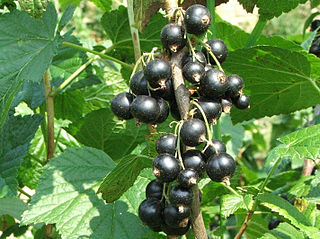
The blackcurrant, also known as black currant or cassis, is a deciduous shrub in the family Grossulariaceae grown for its edible berries. It is native to temperate parts of central and northern Europe and northern Asia, where it prefers damp fertile soils. It is widely cultivated both commercially and domestically.

Zante currants, Corinth raisins, or simply currants outside of the US, are raisins of the small, sweet, seedless grape cultivar Black Corinth. The name comes from the Anglo-French phrase "raisins de Corinthe" and the Ionian island of Zakynthos (Zante), which was once the major producer and exporter. It is not related to black, red or white currants, which are berries of shrubs in the genus Ribes and not usually prepared in dried form.
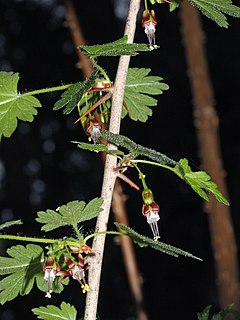
Ribes is a genus of about 200 known species of flowering plants native throughout the temperate regions of the Northern Hemisphere. The various species are known as currants or gooseberries, and some are cultivated for their edible fruit or as ornamental plants. Ribes is the only genus in the family Grossulariaceae.

The redcurrant, or red currant is a member of the genus Ribes in the gooseberry family. It is native across Europe. The species is widely cultivated and has escaped into the wild in many regions.

Ribes sanguineum, the flowering currant, redflower currant, red-flowering currant, or red currant is a North American species of flowering plant in the family Grossulariaceae, native to western United States and Canada, but widely cultivated and naturalized throughout temperate Europe and Australasia.

Ribes viburnifolium, is an uncommon North American species in the gooseberry family. It is known by the common names Catalina currant, Santa Catalina Island currant, island gooseberry and evergreen currant.
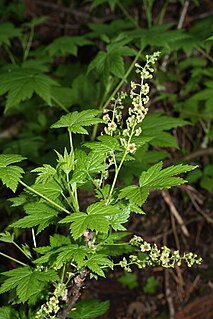
Ribes bracteosum, the stink currant, is a species of currant native to western coastal North America from southeastern Alaska to Mendocino County in California.

Ribes aureum, known by the common names golden currant, clove currant, pruterberry and buffalo currant, is a species of flowering plant in the genus Ribes. It is native to Canada, most of the United States and northern Mexico. The variety Ribes aureum var. villosum is sometimes considered a full species, Ribes odoratum.
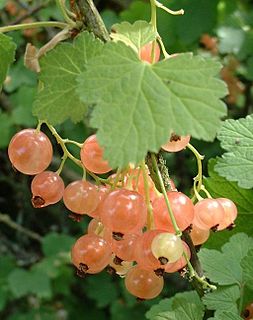
The white currant or whitecurrant is a group of cultivars of the red currant, a species of flowering plant in the family Grossulariaceae, native to Europe. It is a deciduous shrub growing to 1 m (3 ft) tall and broad, with palmate leaves, and masses of spherical, edible fruit (berries) in summer. The white currant differs from the red currant only in the colour and flavour of these fruits, which are a translucent white and sweeter.

Synanthedon tipuliformis, known as the currant clearwing, is a moth of the family Sesiidae. It is endemic to the Palearctic realm, but is an invasive species in the Nearctic realm and the Australasian realm.

Ribes glandulosum, the skunk currant, is a North American species of flowering plant in the currant family. It is widespread in Canada and is also found in parts of the United States.
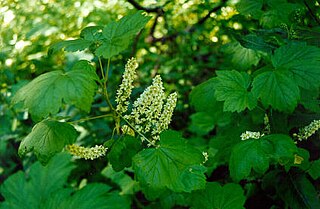
Ribes hudsonianum is a North American species of currant, known by the common name northern black currant.

Ribes montigenum is a species of currant known by the common names mountain gooseberry, alpine prickly currant, western prickly gooseberry,and gooseberry currant. It is native to western North America from Washington south to California and east as far as the Rocky Mountains, where it grows in high mountain habitat types in subalpine and alpine climates, such as forests and talus. It is a spreading shrub growing up to 1.5 meters tall, the branching stems covered in prickles and hairs and bearing 1 to 5 sharp spines at intervals.
Ribes nevadense is a species of currant known by the common names Sierra currant and mountain pink currant.

Ribes viscosissimum is a North American species of currant known by the common name sticky currant. It is native to the Pacific Northwest, Columbia Plateau, Great Plains, Great Basin and Southwestern regions of western North America.
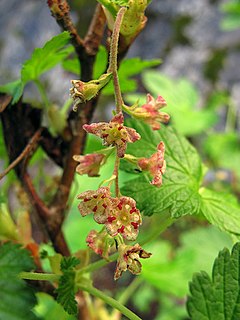
Ribes acerifolium is a North American species of currant known by the common names mapleleaf currant and maple-leaved currant. It is native to the Canadian Province of British Columbia as well as to the northwestern United States.

Blackcurrant production in the United States is relatively limited. The plant was introduced by English settlers at the Massachusetts Bay Colony in 1629 and was cultivated on some scale, particularly in New York. The plant acts as a host for the white pine blister rust that threatened the timber industry. In 1911, the federal government banned the cultivation, sale and transport of blackcurrants to protect the white pine. Government programs systematically destroyed blackcurrant plants by chemical spraying.
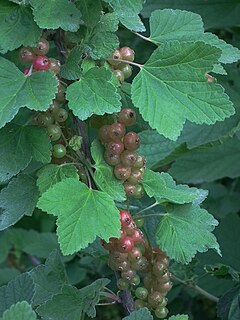
Ribes spicatum, the downy currant or Nordic currant, is a species in the genus Ribes, native to northern Europe and northern Asia. Its bright red berries are edible and quite good‑tasting. It can be differentiated from the more common redcurrant not so much by its leaf hairs, as these tend to fall of as the leaf ages, but by other characteristics: the leaves of R. spicatum are a duller and darker green than R. rubrum with its paler yellowish‑green leaves. R. spicatum holds its leaves at a right angle to the stem, whereas R. rubrum leaves are less erect, markedly distinguishing the overall form of the bushes. R. spicatum has green petioles, but R. rubrum petioles are more orange‑ish.
















